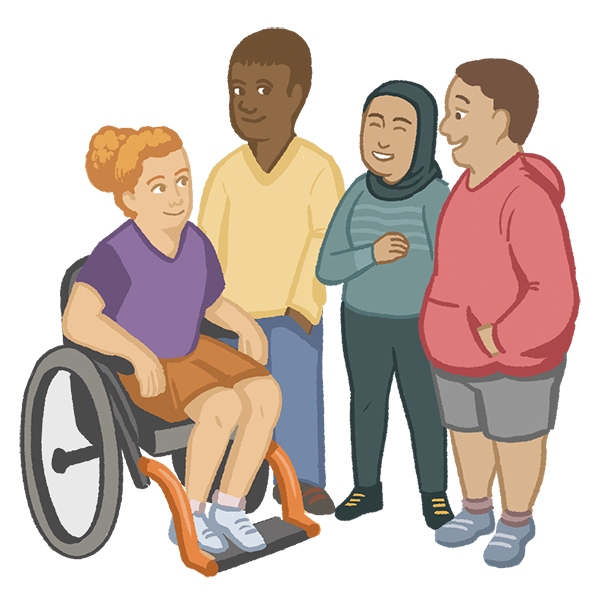UNDERSTANDING IDENTITIES IN THE CLASSROOM TO CREATE AN IDENTITY-SAFER ENVIRONMENT

The classroom is a direct reflection of our society. The intersections[1] and identities that engage within a classroom create the opportunity for students to be able to learn how to be informed active participants of society. An intersectional lens of teaching that considers identity and systemic barriers[2] allows educators to not perpetuate systems of inequity creating a safe space for students to learn.
Domains of Identity Safety
Edutopia[3] highlights four domains: student centered teaching, cultivating diversity as a resource, classroom relationships, and caring classroom environments. The domains work concurrently to create transformative trust, belonging, and a sense of autonomy for students in the classroom. These domains are helpful methods for educators to create Identity- safe learning environments for their students where belonging is fostered for students of all backgrounds.
- Student Centered Teaching Strategies
Suggestion: The Chill Fair[4] exercise in Stress Lessons grades 7-9 allows students to see how others address stressful situations, and creates space for them to check in on each other in response to the exhibits.
This domain focuses on providing students with a sense of autonomy by centering their voice in the learning process. By including students’ ideas and interests in lesson plans and classroom activities, the classroom will reflect the diverse sets of identities and life experiences of the students.
- Allow students to set social and academic goals, reflect on their cooperation with students, propose ways for them to improve.
2. Cultivating Identity as a resource
Suggestion: The “Problem Solving: Articulate-Identify-Evaluate” method in SL grades 9-11[5] gives autonomy to the student and helps them identify their strengths and areas of support in response to a stressor. Similarly, the “Stress Busting” activity in KHST! Grades 4-6[6] walks the student through matching various stress-relieving options with the stressor they may be experiencing.
Utilizing diversity as a resource for learning is integral in allowing students to co-create activities and lessons because it allows them to draw on their own experiences and unique backgrounds.
- Incorporate the cultures of students into the classroom by asking them to mark their holidays, and include activities, stories and games that reflect their backgrounds. When students are identifying their strategies or stressors, leave space for culturally-relevant solutions.
3.Classroom Relationships
Suggestion: Talking Circles[7] on page 20 of the SL grades 9-12 guide is a way that can help create a sense of belonging. Engaging in Talking Circles is a way to model and practice respectful dialogue and active listening. A safer space is created to support difficult conversations, encouraging representatives from a variety of identities to participate equally.
This domain is rooted in educators creating a classroom environment where there is a foundational trust between the students and the educators as well as the availability for learning differently according to the students’ needs.
●Educators create this space by cultivating a sense of belonging in the classroom ensuring the lines of communication between themselves and the students are clear.
4.Caring Classroom environments
Suggestion: The “Problem Box” exercise in KHST! Grades 1-3[8] gives students control over stressful situations by allowing them to both identify their stressor, and share their solutions.
The final domain is focused on the prosocial development in the classroom. Focusing on the emotional tone of the classroom allows educators to check on whether or not students feel physically and psychologically safe in the classroom. Focusing on the emotional tone of the classroom supports the development of students’ academic and social skills.
Educators can create these environments through:
●Incorporating the various activities in the KHST! and Stress Lessons Guides,
●Creating moments during the day where students can come up to the teacher and check in about any possible positive or negative experiences that occurred during the day,
●Inviting students to engage in deep breathing activities[9] when appropriate.
[1] Coined by Kimberlé Crenshaw in 1989, intersectionality is the interconnected nature of social categorizations such as race, class, gender identity, sexual orientation, (dis)ability, religion, and other identity markers as they apply to a given individual or group, which create overlapping and interdependent systems of discrimination or disadvantage. For example, Intersectionality recognizes that identity markers (e.g., “woman” or “black”) do not exist independently of each other, and that each informs the others, often creating a complex convergence of oppression. In this example, in order to understand the oppression of Black women, it is necessary to look at the intersection of blackness and womanhood. This works the same way for markers of identity that embody privilege (e.g., “white”, “man”, “rich”, or “straight”). All aspects of our identities – whether those aspects are oppressed or privileged by society – interact with one another. We experience the aspects of our identities collectively and simultaneously, not individually. The aspects of our identities that are privileged can also affect the aspects that are oppressed. Yes, privilege and oppression intersect — but they don’t negate one another.
[2] Organizational or systemic barriers are policies, procedures, or practices that unfairly discriminate and can prevent individuals from participating fully in a situation.
[3] McCarthy, J. (2015, September 9). Student-Centered Learning: It Starts with the Teacher. Edutopia; George Lucas Educational Foundation. https://www.edutopia.org/blog/student-centered-learning-starts-with-teacher-john-mccarthy
[4]SMSKPC Stress Lessons Guide (Grades 7-9, page 18)
[5] SMSKPC Stress Lessons Guide (Grades 9-11, page 18)
[6] SMSKPC Kids Have Stress Too! Guide (Grades 4-6 page 12)
[7] SL Guide (grades 9-12), page 20
[8] SMSKPC Kids Have Stress Too! Guide (Grades 1-3 page 40)
[9] KHST! Guide (grades 4- 6), page 21.